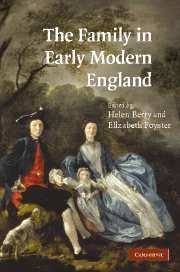Book contents
- Frontmatter
- Contents
- Preface
- Notes on contributors
- Anthony Fletcher
- 1 Introduction
- 2 Marriage, separation and the common law in England, 1540–1660
- 3 Republican reformation: Family, community and the state in Interregnum Middlesex, 1649–60
- 4 Keeping it in the family: Crime and the early modern household
- 5 Faces in the crowd: Gender and age in the early modern English crowd
- 6 ‘Without the cry of any neighbours’: A Cumbrian family and the poor law authorities, c.1690–1730
- 7 Childless men in early modern England
- 8 Aristocratic women and ideas of family in the early eighteenth century
- 9 Reassessing parenting in eighteenth-century England
- Select bibliography
- Index
5 - Faces in the crowd: Gender and age in the early modern English crowd
Published online by Cambridge University Press: 31 July 2009
- Frontmatter
- Contents
- Preface
- Notes on contributors
- Anthony Fletcher
- 1 Introduction
- 2 Marriage, separation and the common law in England, 1540–1660
- 3 Republican reformation: Family, community and the state in Interregnum Middlesex, 1649–60
- 4 Keeping it in the family: Crime and the early modern household
- 5 Faces in the crowd: Gender and age in the early modern English crowd
- 6 ‘Without the cry of any neighbours’: A Cumbrian family and the poor law authorities, c.1690–1730
- 7 Childless men in early modern England
- 8 Aristocratic women and ideas of family in the early eighteenth century
- 9 Reassessing parenting in eighteenth-century England
- Select bibliography
- Index
Summary
In early modern England, men did it, women and youths did it, even little children on occasion did it – they all participated in protest. But within the historiography of the crowd that developed in the 1950s and 1960s, the participation of all these groups, to the extent that their separate inclusion in protest was even noted, was largely subsumed within the grand narratives of the emergence of class and the struggle for citizenship. Causation in terms of the grievances of the ‘rioters’, itself located in underlying narratives of the impact of modernisation, capitalist agriculture, industrialisation, and the growth of the state, was held to explain participation in protest. Thus, when historians began to identify faces in the crowd the faces were those of men, and for the pioneer of this approach in Britain – George Rudé – predominantly those men whose modest property and marginal political participation rescued them from contemporary identifications of protesters as ‘the mob’.
Issues of status in terms of gender or age had little or no place in these narratives. The emergence of a feminist/women's history, to which pioneering work on pre-industrial protest made its own contribution, was the first explicitly to challenge the neglect of gender in explaining issues of participation. Much of the inspiration for this work was also shaped by reference to grand narratives, not least those of subordination/resistance and oppression/emancipation. When Lawrence Stone produced Family, Sex and Marriage, he was able to draw on this work.
- Type
- Chapter
- Information
- The Family in Early Modern England , pp. 96 - 125Publisher: Cambridge University PressPrint publication year: 2007



